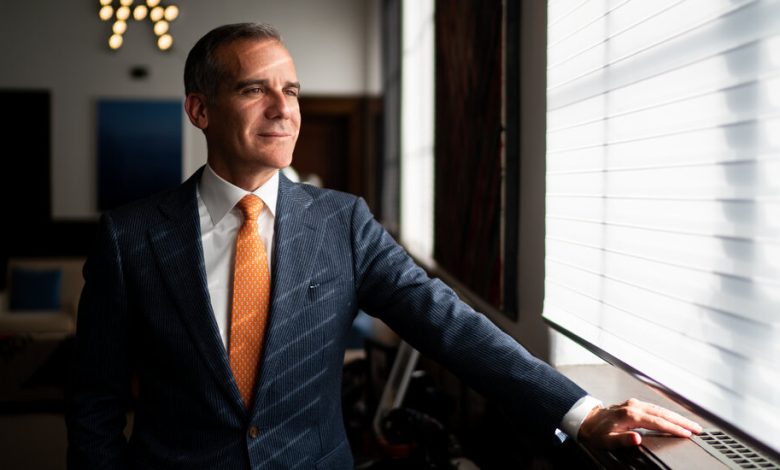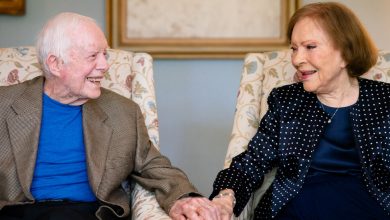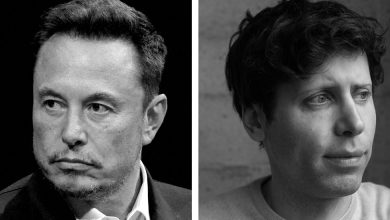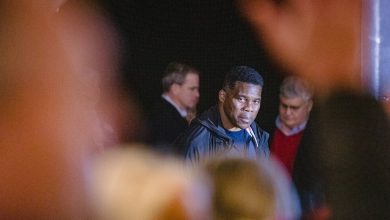A Conversation With Eric Garcetti, Who Led Los Angeles for Nearly a Decade


Mayor Eric Garcetti, who is ineligible for re-election because of a two-term limit, became the city’s 42nd mayor nearly a decade ago.Credit…Erin Schaff/The New York Times
LOS ANGELES — On a chilly morning last week in Chinatown, a semicircle of cameras clicked around Eric Garcetti as grinning supporters lined up to shake his hand.
Garcetti ended his nearly decade-long tenure as mayor of Los Angeles on Sunday as Karen Bass took over the city, the second biggest in the nation. “You set the table for the meal that comes next,” Garcetti said at one of his final mayoral events to announce the creation of new affordable housing projects.
He was in a reflective mood when I met up with him for an hourlong conversation as he drove from Chinatown to Marina del Rey for the groundbreaking of another housing project. Garcetti, 51, handed over the reins to Los Angeles at a tumultuous time, as the city struggles with a homelessness crisis, rising Covid rates and persistent racial tensions.
On Monday, as the leadership change was underway, City Councilman Kevin de León was facing a new round of criticism after he got into an altercation Friday night with an activist. De León was among four Latino leaders who discussed local politics in racist terms on a bombshell recording that leaked earlier this year, and he has remained in office despite calls to resign.
Gil Cedillo, who was also recorded on the tape and whose City Council term ended on Sunday, released a defiant defense on Monday in which he explained why he chose not to step down earlier and portrayed the blowback against him as unfair. “My critics’ warped zealotry isn’t a sign of a growing movement for racial justice,” he wrote. “It’s a glaring problem.”
When I asked Garcetti about the impacts of the tape, he said he believed the comments “crossed the line” and merited resignation. But he added that he was hopeful that most Angelenos’ responses had solidified coalitions in the city as opposed to sowing further rifts.
Here are parts of our conversation, lightly edited for length and clarity.
I’ll start with an easy one. What are some of the things you’re proudest of?
I’m really glad we looked both at managing the crises of today and tried to build the city of tomorrow. Because I think L.A.’s history is the failure to look too far ahead. Besides bringing water and building freeways, most of our big infrastructure needs have always been reactive. We strengthen buildings after earthquakes. We respond to racism and economic injustice after a riot. We wait for a housing crisis and a homelessness crisis to be there before we say, “Oh, maybe 40 years of NIMBYism didn’t help us create a just city.”
Every time I’ve spent my political capital, whether it was on film tax credits at the state level for a core industry that was leaving, whether it was Measure M, the transportation ballot measure, or the Olympics for a year I wouldn’t even be here as mayor, or housing measures, I’m kind of proud of what people can’t see. Because I think if you do your job, you do it for what comes next.
Which isn’t to say we didn’t do things as they happened. During the pandemic, I’m most proud of the city that I saw come together against the biggest threat we’ve ever faced, probably since World War II.
More on California
- L.A.’s New Mayor: Vice President Kamala Harris swore in Karen Bass as the first female mayor of the nation’s second-largest city in a ceremony that celebrated her historic win but also underscored the obstacles ahead.
- Employee Strike: Postdoctoral students and academic researchers at the University of California said that they would return to work, partly ending a weekslong strike to demand higher pay. Some 36,000 workers remain on strike.
- Remaking a River: Taming the Los Angeles River helped Los Angeles emerge as a global megalopolis, but it also left a gaping scar across the territory. Imagining the river’s future poses new challenges.
- A Piece of Black History Destroyed: Lincoln Heights — a historically Black community in a predominantly white, rural county in Northern California — endured for decades. Then came the Mill fire.
I covered your first State of the City address as a reporter at The Los Angeles Times. I reread that story from 2014, and it felt to me like Los Angeles was an entirely different place then. You’ve alluded to this before, but why does the city feel — for lack of a better word — like a darker place now?
We’ve lived through the trauma of a pandemic. The cresting of a housing crisis 40 years in the making. I would describe it not necessarily as darker, because I still see a lot of shades of light. I would say harder. It’s harder to live here than it’s been in my lifetime.
The California Dream was predicated on great weather, which we have; great people, which we have; great jobs, which we have; really good public schools and affordable housing. Schools are a mixed bag. Our public universities are still great, but our public schools in general are not what they were, and housing is like an F, statewide.
Los Angeles is one of the most diverse places in the world, and the leaked recording seems to have stoked ethnic and racial divisions here. What advice do you have for Mayor Bass to help create cohesion?
I’m not worried about her. She kind of gets it instinctively. She was speaker of the State Assembly, and to run legislative bodies you have to figure out everyone else’s needs. She lived in the San Fernando Valley, has Latino members of her family and is African American. I think she’s actually brilliant for that work, and for this moment.
So what’s next for you? Are you going to be the U.S. ambassador to India?
I’m optimistic, genuinely. I trust the administration to handle that. Almost two years after my nomination, not only am I still standing, but they’re like “100 percent, absolutely he’s the right person with the right qualifications.” I trust that the majority of senators will vote that way.
Do you have any indication of when things are going to get rolling?
I stopped trying to. I think it would be the next two or three months. Hopefully by spring I would be able to be on the ground.
What are your plans for the first few weeks after you step down as mayor?
I’m going to go skiing later this month. I really want to see a matinee. I’m going to read novels. A bunch of hiking. Volunteer at my daughter’s school. I can’t wait to drive around: Driving L.A. at night listening to music, with the windows down.
The rest of the news
-
Flavored tobacco: The U.S. Supreme Court refused to block a California law banning flavored tobacco, clearing the way for the ban to take effect next week.
-
U.C. strike: Darrell Steinberg, the mayor of Sacramento, has been chosen to mediate the U.C. strike, San Francisco Standard reports.
SOUTHERN CALIFORNIA
-
Mountain lion: Wildlife authorities captured Los Angeles’s infamous puma, otherwise known as P-22, in a resident’s yard after concerns about his recent behavior.
-
Water resources: As droughts dry the area around Los Angeles, the Superfund site at the San Fernando Valley groundwater basin will serve as a new source of water for the city, The Los Angeles Times reports.
CENTRAL CALIFORNIA
-
Kidnapping attempt: A 17-year-old girl escaped an attempted kidnapping in Stockton by jumping out of a vehicle, CBS News reports.
NORTHERN CALIFORNIA
-
Parklets: Napa, Marin and Sonoma Counties are retaining pandemic-era “parklets” as permanent fixtures, The North Bay Business Journal reports.
-
Coastal property: One of the greatest conservation stories on the San Mateo County coast is about to come to a close with 6,300 acres of rolling hills and valleys moving into public hands, The San Francisco Chronicle reports.
What you get
$1.3 million homes: A hillside house in Lake Arrowhead, a two-bedroom condominium in San Francisco and a Tudor Revival cottage in Long Beach.
What we’re drinking
The most memorable wines of 2022.
Where we’re traveling
Today’s tip comes from Kathy Hanten, who lives in San Diego:
Tell us about your favorite places to visit in California. Email your suggestions to [email protected]. We’ll be sharing more in upcoming editions of the newsletter.
Tell us
We’re writing about how Californians celebrate the holidays. Do you relax by the beach, visit Disneyland or make tamales with your family? Maybe you always travel to a special spot within the Golden State?
Email us at [email protected] your California holiday traditions and memories. Please include your name and the city where you live.
We may include your email response in an upcoming newsletter or in print. By emailing us a response, you agree that you have read, understand and accept the Reader Submission Terms in relation to all of the content and other information you send to us (“Your Content”). If you do not accept these terms, do not submit any content.
And before you go, some good news
Tammah Watts remembers the exact moment she became a bird-watcher.
It was April 2007. She was stuck in her house, struggling with chronic pain resulting from complications after a surgery. The pain had become so debilitating that Watts, formerly an avid biker and hiker, couldn’t hold a pencil or pick up a cup at times. It had forced her to leave her job as a therapist and confined her to her home, where she had sunk into a deep depression.
Then one day, she looked out her kitchen window. She saw a bright yellow bird. She was entranced.
Every day she watched it jump from branch to branch, barely discernible from the yellow blossoms of the tipu tree. And over time, this bird led her to others in her yard and brought Watts out of her pain and sadness and back into the world.
She started keeping track of the birds she saw, joined a local Audubon Society chapter and traveled the state looking for new birds. She now sits on the Audubon California board of directors. In short, she said, birding changed her life.
Read more about the health benefits of bird-watching.
Thanks for reading. I’ll be back tomorrow. — Soumya
P.S. Here’s today’s Mini Crossword.
Briana Scalia and Steven Moity contributed to California Today. You can reach the team at [email protected].
.





